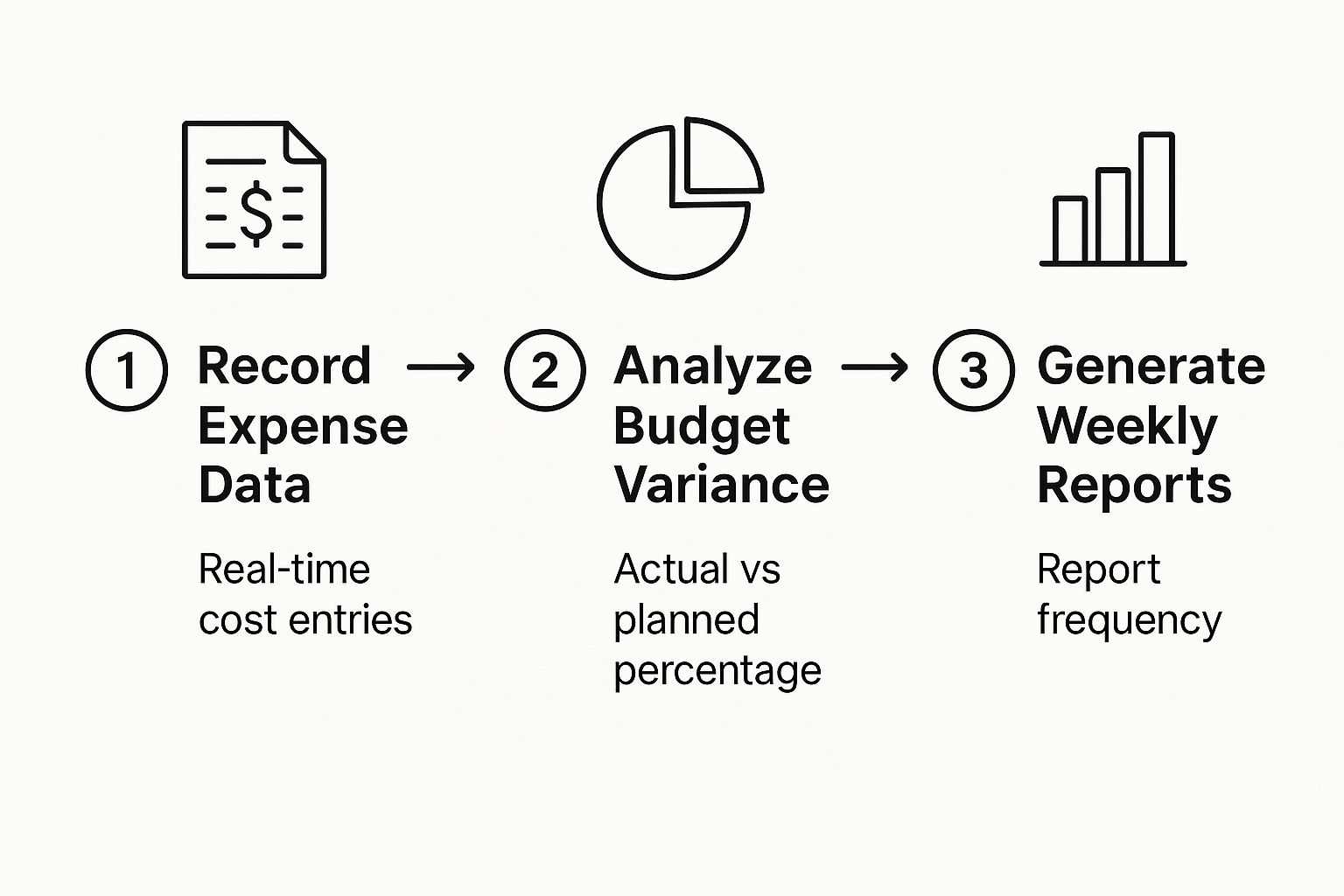In the high-stakes world of Bay Area construction, construction budget management is the critical discipline that separates profitable projects from financial disasters. For builders, contractors, and architects in Berkeley, Oakland, and beyond, mastering your budget isn't just a task—it's the foundation of your business's success and reputation. It's the entire process of planning, estimating, tracking, and controlling every dollar to ensure you finish every job in the black.
For any professional working in this demanding market, disciplined budgeting is non-negotiable. It's the blueprint that guides your project from concept to completion, protecting your margins and building client trust along the way.
Why Effective Budgeting is Crucial for Bay Area Projects

Let's be direct—managing a construction budget here is a different beast. We're juggling some of the highest land values, labor rates, and material costs in the United States. This creates a high-stakes environment where a successful project in Berkeley or Oakland is defined by its financial precision.
This is where a disciplined approach to budgeting becomes your most valuable asset. It’s more than a spreadsheet; it's your playbook for navigating the region’s unique economic pressures and delivering value to your clients.
The True Cost of Poor Budget Control
In markets like San Francisco, budget overruns can feel like an unavoidable part of the job, but they don’t have to be. According to the National Association of Home Builders (NAHB), poor budget management is a leading cause of project failure. A rock-solid budget provides a clear advantage in a competitive landscape.
- Gain Financial Control: A detailed budget sets a clear baseline, helping you spot potential overruns early and take action before they become major problems.
- Make Smarter Decisions: When you know exactly where your money is allocated, you can make informed calls on everything from material substitutions to subcontractor bids.
- Build Client Trust: A transparent budget builds immense trust, especially when discussing change orders. No homeowner or developer in the Bay Area likes financial surprises.
- Protect Your Profitability: Ultimately, tight budget control is the most direct route to protecting your margins on every single project you undertake.
A well-managed budget is so much more than numbers. It’s a communication tool, a risk management strategy, and a roadmap to profitability. It gets everyone—from the architect in Berkeley to the homeowner in San Francisco—aligned on financial expectations from the start.
This guide provides a practical framework for Bay Area builders, contractors, and remodelers. We’ll walk through how to build accurate estimates, track expenses diligently, and manage the specific risks of building in this demanding region.
Core Components of a Successful Construction Budget
To bring it all together, a modern budget strategy relies on a few essential pillars. Each one has a clear goal and specific tasks that keep your project on track from start to finish.
| Pillar | Objective | Key Activities |
|---|---|---|
| Accurate Estimating | Create a realistic financial baseline grounded in local data. | Detail line-item costs, factor in Bay Area labor rates, secure vendor quotes, and analyze historical project data. |
| Contingency Planning | Mitigate financial risks from unexpected issues. | Allocate 10-15% of the total budget for unforeseen problems, price fluctuations, and delays common in Bay Area construction. |
| Real-Time Tracking | Maintain constant visibility into every dollar spent. | Use software to log all expenses, reconcile invoices against the budget, and monitor cash flow daily or weekly. |
| Change Order Management | Control scope creep and its financial impact professionally. | Document all changes in writing, get client sign-off on costs before work begins, and update the master budget immediately. |
This structured approach transforms your budget from a static document into a dynamic management tool, giving you the control needed to navigate the complexities of any Bay Area construction project.
How to Build an Accurate Cost Estimate from the Ground Up

A project lives or dies by the accuracy of its initial budget. Creating a detailed, reality-based cost estimate is the most critical step in construction budget management, especially here in the expensive Bay Area market. An estimate isn’t just a shopping list; it's the comprehensive financial blueprint for the entire build.
This is the point where you must move past vague percentages and dig into real-world numbers. Getting this step wrong sets you up for budget overruns that erode profits and damage client trust before a single foundation is poured.
Deconstructing Your Project into Key Cost Categories
To build an accurate budget, you first have to break the project down into its core cost categories. This ensures no major expense slips through the cracks. For any build in the Bay Area, a professional estimate must meticulously account for these areas.
- Direct Material Costs: This includes everything from framing lumber and plywood for a Berkeley new build to the high-performance Marvin windows needed for a historic San Francisco remodel. You need current quotes from local suppliers who understand this market.
- Bay Area Labor Costs: This covers wages, benefits, and insurance for your crew and every subcontractor. It's no secret that Bay Area labor rates are among the highest in the country, so using national averages is a recipe for disaster.
- Equipment and Tools: Factor in rental or purchase costs for all machinery, from scaffolding and lifts to specialized tools. Remember to add costs for fuel, delivery, and routine maintenance.
- Permits, Fees, and Insurance: Navigating the regulatory maze in cities like Berkeley and Oakland comes with a hefty price tag. This includes building permits, planning reviews, specialty inspections (like seismic or energy audits), and your project-specific insurance policies.
- Overhead and Profit: These are the real costs of doing business that aren't tied to one specific job site. A healthy, sustainable construction business always bakes overhead costs and a target profit margin into every estimate.
Sourcing Real-World Pricing for the Bay Area
Forget generic online cost calculators; for our region, they're notoriously unreliable and can get you into trouble fast. A trustworthy budget is built on real, localized data from suppliers who have a finger on the pulse of the market. This means building relationships is key.
When pricing a package of Andersen windows or a truckload of lumber, calling a local supplier like Truitt & White gives you more than a number. You get current pricing, crucial lead-time information to prevent delays, and expert advice on materials meeting tough local codes like California's Title 24. To see how these pieces fit together, review our guide on the construction process in the San Francisco Bay Area.
Pro Tip: Never rely on a single quote for anything significant. Always get at least three bids for major material packages and subcontractor trades. It’s the only way to ensure you’re getting competitive, fair market pricing and is a cornerstone of responsible financial management.
The Non-Negotiable Contingency Fund for Local Risks
Let’s be honest: no project goes exactly as planned, especially with the complex builds common in the Bay Area. You might open a wall and find dry rot in an old Victorian, encounter unexpected soil conditions, or get hit with a sudden material price spike. A contingency fund is not for mistakes; it’s a planned buffer to absorb these inevitable curveballs.
For most projects here, a contingency of 10-15% of your total estimated cost is standard practice. For a riskier job—like a hillside build or a gut remodel with many unknowns—pushing that closer to 20% is a smart move. Think of it as your project's most important financial safety net.
Strategies for Tracking and Controlling Your Budget
Once the budget is approved, the real work of financial discipline begins. Effective construction budget management means your budget becomes a living tool used every single day, not a document you file away. The goal is simple: maintain constant, clear visibility into where every dollar is going.
This active monitoring allows you to compare actual spending against your plan, ensuring there are no costly surprises when the project wraps up. It’s the key to protecting your hard-earned profit margins.
Choosing the Right Cost Tracking System for Your Business
Your tracking system can be your best friend or your worst enemy. A complex commercial build in downtown San Francisco might demand sophisticated software, while a smaller Berkeley remodel could be managed with a well-organized spreadsheet. The tool should fit the job.
- Dedicated Construction Software: Platforms like Procore or Buildertrend are the industry standard for a reason. They integrate everything from expense tracking and purchase orders to real-time budget reports for complex jobs.
- Smart Spreadsheets: For smaller jobs, a thoughtfully designed spreadsheet in Excel or Google Sheets can work effectively. The key is to create detailed line items for every cost, with columns for budgeted amounts, actual spending, and the variance.
The specific tool you choose matters less than your team's discipline in using it. Every single expense, from a box of screws to a major lumber delivery, must be logged promptly. This habit provides a true financial picture of your project's health in real time.
This simple workflow shows how to turn daily financial tracking into a repeatable habit.

This process isn’t about creating more paperwork; it’s about shifting from reactive problem-solving to proactive financial control.
For contractors navigating the Bay Area's competitive landscape, choosing the right method for tracking costs is a foundational decision.
A Comparison of Cost Tracking Methods
| Method | Pros | Cons | Best For |
|---|---|---|---|
| Manual Ledgers/Spreadsheets | – Low cost (or free) – Highly customizable – Simple to set up and use | – Prone to human error – Time-consuming data entry – Lacks real-time collaboration | Smaller contractors, simple remodels, or those just starting out. |
| Accounting Software (e.g., QuickBooks) | – Integrates with banking – Good for overall business finance – Generates standard financial reports | – Not construction-specific – Can be difficult to track job costs – May require workarounds | Small to mid-sized builders who need a single tool for business and project accounting. |
| Integrated Construction Management Software (e.g., Procore, Buildertrend) | – All-in-one project management – Real-time data and reporting – Built-in collaboration features | – Higher cost (subscription fees) – Can be complex to learn – May be overkill for small jobs | Mid-sized to large contractors running multiple, complex projects. |
Ultimately, the best system is the one your team will actually use consistently. Whether it's a meticulously managed spreadsheet or a powerful software suite, consistency is what delivers the financial insights you need to stay profitable.
Proactive Cost Control And Financial Housekeeping
Simply tracking expenses isn't enough; you must actively manage them. This comes down to good financial housekeeping to maintain accuracy and prevent cash flow crunches that can halt a project.
Efficiently handling invoices is a huge part of this. When a bill arrives, it must be immediately checked against the purchase order and completed work. To keep cash flowing while waiting on client payments, options like invoice factoring in the construction industry can be a game-changer, turning unpaid invoices into working capital.
Additionally, precise tracking of labor hours is non-negotiable. Labor is almost always one of your largest and most variable costs. Using digital timesheets or a reliable logbook ensures you pay for hours actually worked and can tie those costs back to specific project phases.
The Power Of Regular Budget Reviews
The weekly budget review meeting is your early warning system. This shouldn’t be a formal, stuffy meeting, but rather a practical huddle with your project manager or site supervisor. This is where you catch a potential 5% overrun before it balloons into a 25% disaster.
This consistent oversight is what separates the most disciplined and profitable builders from the rest. It creates a culture of financial accountability across your entire team.
In these meetings, compare actuals to the budget, line by line. Get in the habit of asking tough questions:
- Are we trending over or under budget on framing labor?
- Did that window package come in at the price we were quoted?
- Are we tapping into our contingency fund faster than we should be?
This routine review process keeps everyone focused on the project's financial goals. It builds on the same principles of communication and trust that are central to customer service excellence for professional builders.
How to Professionally Handle Change Orders and Project Risks

No matter how airtight your initial plan, projects change. In the Bay Area, unexpected issues and client requests are givens, not possibilities. Effective construction budget management is about having a rock-solid process for when things inevitably go off-script.
Without a formal system, scope creep can quietly destroy your profit margins. A simple client request for different hardware or finding unexpected rot in an old Oakland home can snowball into budget overruns if not handled with precision.
Mastering a Formal Change Order Process
A change order must be a documented, professional transaction, not a casual "sure, we can do that" on the job site. A disciplined process protects you and your client, ensuring every adjustment is priced, approved, and formally added to the scope before work begins.
Here’s a straightforward four-step process for managing change orders:
- Document Everything in Writing: The moment a change is requested, document it. Note the date, who requested it, and a clear description of the new work.
- Price the Full Impact Accurately: Calculate the entire cost, including materials, labor, and any impact on the project schedule, which has its own financial implications.
- Present and Get a Signature: Provide the client a formal change order document outlining the added cost and any schedule extension. Do not start work until you have signed approval.
- Update Your Master Budget Immediately: Once approved, the change order gets plugged right back into your budget tracking system to reflect the project's new reality.
A change order isn't a problem; it's a contract amendment. Treating it with this formality builds client trust and ensures you are paid fairly for all your work, turning a potential headache into a routine business transaction.
Getting Ahead of Common Bay Area Project Risks
Beyond client requests, building in our region comes with its own set of challenges. Spotting these potential hurdles early allows you to build a smarter contingency plan. A great place to start is by defining crystal-clear project boundaries with a comprehensive project scope template.
Here are some of the most common risks on Bay Area job sites:
- Supply Chain Delays: Sourcing specific materials—from custom windows for a San Francisco Victorian to specialized seismic hardware—can involve long lead times. Ordering durable materials far in advance is a smart move, and our guide on choosing long-lasting materials for your projects can help you plan.
- Navigating Local Regulations: Meeting strict Title 24 energy codes or historic preservation rules in neighborhoods like Berkeley adds complexity and cost. Research these requirements during planning, not after breaking ground.
- Skilled Labor Shortages: The demand for skilled trades here is intense, which can lead to scheduling logjams and drive up labor costs. Lock in your trusted subs early to secure their availability and pricing.
Anticipating these challenges makes your budget far more resilient. Your contingency fund transforms from a generic safety net into a strategic reserve, giving you more control over the financial outcome of your project.
Using Technology and Local Partnerships to Your Advantage
In today’s market, smart construction budget management goes beyond a well-kept spreadsheet. The most successful builders, architects, and remodelers in the Bay Area are gaining a critical edge by combining modern technology with strategic local partnerships. This powerful duo creates a financial advantage that helps you work faster and forecast more accurately.
Relying solely on manual processes leaves you vulnerable to costly data entry mistakes and communication delays. Adopting the right digital tools creates a single source of truth for your project’s financial health that your entire team can access.
Embracing Construction Management Software
Platforms like Procore and Buildertrend have become essential for managing the complex finances of modern construction jobs. They centralize every piece of financial management—from estimation and bidding to real-time expense tracking, purchase orders, and change orders—into one hub.
This provides a live, transparent view of your budget at all times. This level of insight allows you to spot potential overruns long before they become emergencies. The real magic is how these systems connect the field to the office, eliminating guesswork and empowering you to make sharp financial decisions on the fly.
The Strategic Value of a Local Supplier Partnership
While technology provides the data, local partnerships offer on-the-ground support that software can't. Building a strong relationship with a local supplier like Truitt & White is one of the most effective cost-control strategies a Bay Area contractor can have. This partnership goes far beyond just placing orders.
A trusted local partner offers several key benefits:
- Reliable Pricing and Material Availability: They live and breathe the regional market, providing accurate, current pricing that protects your estimates and helps you avoid costly delays from material shortages.
- Expert Guidance on Bay Area Building Codes: A knowledgeable supplier can recommend materials that meet specific local rules like Title 24 energy standards or seismic regulations, preventing expensive rework.
- Logistical Support and Timely Deliveries: Managing deliveries in dense areas like Oakland or Berkeley requires precision. A local supplier who knows the streets ensures materials arrive exactly when needed, keeping your project on schedule. Learn why Oakland contractors choose to partner with us in Berkeley.
This blend of digital efficiency and human expertise is vital as global construction costs shift. A recent Arcadis report highlighted how urban construction costs vary dramatically by city. By using technology for analysis and strong local partnerships for a reliable supply, Bay Area builders can better navigate this complex landscape. You can explore the full 2025 construction costs report from Arcadis to learn more.
By pairing the powerful analytics of modern software with the practical wisdom of a dedicated local supplier, you transform your approach to construction budget management. You move from simply reacting to costs to proactively controlling them.
Frequently Asked Questions About Construction Budgeting
Here are answers to some of the most common questions we receive from builders, remodelers, and homeowners about managing construction budgets in the Bay Area.
1. How much should I set aside for a contingency fund in the Bay Area?
For most new construction and remodeling projects in Berkeley, Oakland, and the greater Bay Area, a contingency fund of 10% to 15% of the total project cost is a wise baseline. For more complex jobs like historic renovations or hillside builds with many unknowns, increasing that to 20% provides a crucial financial safety net.
2. What's the biggest budgeting mistake Bay Area contractors make?
A frequent and costly mistake is creating an incomplete initial estimate that overlooks "soft costs." Expenses like specialty permit fees, site security, temporary utilities, and extensive cleanup can add up quickly and erode profit margins if not accounted for from the start.
3. How do I handle unexpected costs with a client without damaging our relationship?
The key is immediate and transparent communication. Bring up potential overruns the moment you identify them, not after the money has been spent. Use a formal, written change order that details the new costs and schedule impacts, and get a client signature before proceeding with the additional work.
4. Are there ways to save on building material costs without sacrificing quality?
Absolutely. Building a strong relationship with a local supplier like Truitt & White is a primary strategy. We can recommend cost-effective alternative materials, provide accurate lead times to avoid rush orders, and offer competitive pricing. Planning ahead and ordering in bulk can also help you lock in better prices and avoid market fluctuations.
5. Is a spreadsheet good enough for tracking project costs?
For very small, simple jobs like a single-room remodel, a meticulously organized spreadsheet can work. However, as project complexity increases, spreadsheets become prone to human error. For most professional projects, investing in construction management software like Procore or Buildertrend provides far more reliable, real-time tracking and reduces financial risk.
For more answers to common questions, you can always check out the main Truitt & White FAQ page for additional information.
Ready to build a more accurate and resilient budget for your next Bay Area project? The experts at Truitt & White can provide reliable quotes, material recommendations, and the logistical support you need to keep your finances on track. Visit our Berkeley showroom or connect with us today for expert advice.









